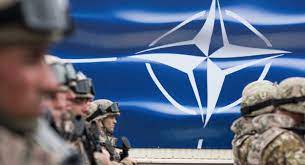The Nato military alliance could soon expand, with both Finland and Sweden expected to apply for membership.
Nato countries are currently supplying Ukraine with billions of dollars-worth of weapons to counter the Russian invasion, ranging from missiles to tanks and heavy artillery.
What is Nato?
Nato - the North Atlantic Treaty Organization - is a military alliance formed in 1949 by 12 countries, including the US, UK, Canada and France.
Members agree to come to one another's aid in the event of an armed attack against any individual member state.
Nato's aim was originally to counter the threat of post-war Russian expansion in Europe.
Soviet Russia responded by creating its own military alliance of eastern European communist countries, called the Warsaw Pact.
After the Soviet Union's collapse in 1991, a number of former Warsaw Pact countries joined Nato.
Could Sweden and Finland join Nato?
US officials expect Sweden and Finland to bid for membership as early as June.
If they joined it would take the Nato alliance to 32 members.
Russia has warned both countries against doing so.
However, US defence officials said Moscow's invasion of Ukraine has been a "massive strategic blunder" which is likely to bring about Nato enlargement.
Nato´s expansion before and after 1970
Why isn't Nato sending troops to Ukraine?
Because Ukraine isn't a Nato member, the alliance isn't obliged to come to the country's defence.Nato countries fear if their troops confront Russian forces in Ukraine, it could lead to an all-out conflict between Russia and the West.
Nato says its members are "determined to do all we can to support Ukraine,"
but must ensure the war doesn't escalate beyond Ukraine's borders.
This is why Nato rejected imposing a no-fly zone over Ukraine.
However, it has approved setting up four new multi-national battlegroups in Slovakia, Hungary, Bulgaria and Romania - three of which border Ukraine - doubling Nato's presence in the region.
Why is Russia opposed to Nato?
Nato offered Ukraine a path towards membership in 2008. After Russia's annexation of Crimea in 2014, Ukraine made joining a priority.
But this hasn't happened, mainly because of Russia's long-standing opposition.
One of Russia's demands before the invasion was that Ukraine should never be allowed to join - something Nato refused to accept.
Russia believes Nato has been encroaching on its area of political influence by taking on new members from eastern Europe, and that admitting Ukraine would bring Nato right into its backyard.
Ukraine's President Zelensky has accepted his country can't join Nato at present, saying: "It is clear that Ukraine is not a member of Nato. We understand this."
China joins Russia in opposing Nato expansion
Which weapons have the UK and other countries sent to Ukraine?
Initially, Nato countries limited their supplies to defensive weapons.
The UK has sent Ukraine thousands of NLAW anti-tank missiles and some Starstreak anti-aircraft missiles.
The US has sent Javelin anti-tank missiles and Stinger anti-aircraft missiles as part of a $3bn (£2.3bn) military aid package.
Slovakia has sent its S-300 anti aircraft defence system, which can destroy aircraft up to 400km away.
The US and Turkey have both sent drones armed with missiles.
Now several member states are supplying Ukraine with heavier weapons, to enable Ukraine's army to push back against Russia's army in the Donbas
The Czech Republic has sent T-72 tanks and armoured infantry carriers
The UK and Australia are sending armoured vehicles
The US, UK and Canada are sending heavy artillery
The Netherlands is sending self-propelled guns
Germany is considering sending tanks and other armoured vehicles, but has not reached a decision
The EU has said it will spend up to 450m euros (£376m) to fund the supply of weapons to Ukraine. It is the first time in its history that the EU has helped provide arms for a warzone.
Belgium, Poland, Estonia, Latvia, Denmark, Spain and Slovakia are also sending military equipment, including ammunition, fuel and rations.
Are arms shipments to Ukraine making a difference?
How many troops does Nato have in Eastern Europe?
Even before the latest deployments are agreed, Nato already had troops stretching from the Baltic republics in the north to Romania in the south.
They were stationed there in 2014, after Russia's annexation of Crimea, and are designed to act as a "tripwire" in case of a Russian attack.
Nato has sent elements of its 40,000-strong Response Force to Eastern European countries bordering Russia and Ukraine.
It has 100 fighter jets on high alert and 120 ships, including three carrier groups, patrolling the seas from the far north to the eastern Mediterranean.
The US has committed to sending more troops to Europe - joining the existing four multinational battlegroups that Nato has set up in in Estonia, Latvia, Lithuania and Poland, and the multinational brigade it has set in Romania.




